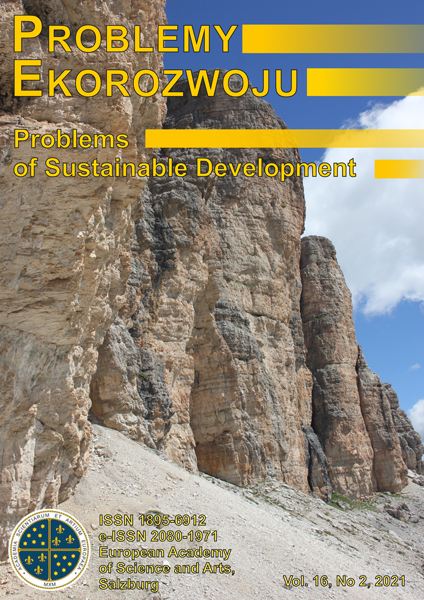Formation Aspects of an Accessible Environment in Modern Landscape Architecture in Azerbijan
Article Sidebar
Open full text
Issue Vol. 16 No. 2 (2021)
-
Prospects for the Reorientation of Investment Flows for Sustainable Development under the Influence of the COVID-19 Pandemic
Olha Prokopenko, Cholpon Toktosunova, Nurmira Sharsheeva, Rita Zablotska, Valerii Mazurenko, Lina Halaz7-17
-
Impact of Coronavirus Pandemic on Financial Market Stability in Africa
Kalu O. Emenike18-25
-
Comparison and Assessment of Factors Affecting the COVID-19 Vaccination in European Countries
Serhii Kozlovskyi, Daria Bilenko, Mykhailo Kuzheliev, Natalya Ivanyuta, Vira Butenko, Ruslan Lavrov26-33
-
Legal Regulation and Reflection of Public Health Emergencies in China on the Example of Coronavirus Pandemic
Lei Song34-40
-
Transformational Leadership: An Approach of Business Sustainability during the COVID-19 Pandemic with Special Reflection to India
Purnima Lenka, Sarita Kar41-50
-
Bhopal Disaster Gas Victims’: Trauma Before & During the COVID-19 Pandemic
Monalisha Mandal, Md. Mojibur Rahman51-57
-
Post-COVID Sustainable Economic Development
Maja Andrijasevic, Vesna Pasic Tomic, Violeta Jovanovic58-65
-
The Concept of Inclusion in the Context of Sustainable Development
Agnieszka Salamucha66-74
-
Factors of Quality of Life in a Group of Selected European Union and OECD Countries
Magdaléna Drastichová, Peter Filzmoser75-93
-
Socioeconomic and Environmental Determinants of Health Outcomes: The Case of Transition Economies
Ebru Çağlayan-Akay, Zamira Oskonbaeva94-107
-
Sustainable Development Management and Building a New Civilization
Franciszek Piontek108-115
-
Management of Social Risks and their Impact on the Spheres of Human Life in the Conditions of Sustainable Development of Ukraine
Halyna Zelinska, Uliana Andrusiv, Olga Galtsova, Mykyta Dmytrechenko116-124
-
Green Smart City as a New Paradigm of Local Development
Ewa Łaźniewska, Izabela Janicka, Tomasz Górecki125-136
-
Integrating Concepts of Blue-green Infrastructure to Support Multidisciplinary Planning of Sustainable Cities
Jan Kopp, Jindřich Frajer, Michal Lehnert, Michal Kohout, Jiří Ježek137-146
-
The Effect of Green R&D Activities on China’s SO2 Emissions: Evidence from a Panel Threshold Model
Shuxing Chen, Ke Liu, Denglong Ding, Zeyu Yue, Zhu Bo, Yuee Tang147-151
-
Cognitive Modeling Concepts of Sustainable Development of Society
Elina Boichenko, Nataly Martynovych, Iryna Shevchenko158-165
-
Sustainable Development and Transhumanism – Enlightenment Visions of Future Generations
Jacek Leszek Łapiński, Łukasz Sadłocha166-170
-
The Future We Want: Sustainable Development Goals Accomplishment with Organic Agriculture
Srđan Šeremešić, Željko Dolijanović, Mirela Tomaš Simin, Bojan Vojnov, Danica Glavaš Trbić171-180
-
Conditions for Unethical Environmental Behaviour in Organizations
Marek Bugdol, Daniel Puciato, Tadeusz Borys181-191
-
The Challenges before Higher Education for the Composite Growth of a Sustainable Society
Anupama Purohit192-198
-
Health Impact Assessment as an Essential Element of Environmental Law in the National Legal Order. Considerations on the Basis of International Law
Maciej Pakowski, Anna Garus-Pakowska199-208
-
Legal Problems Concerning Implementation of Sustainable Ecotourism in Russia
Svetlana Ivanova209-216
-
Role of Innovation in Sustainable Sanitation System: A Case Study of India
Sumit Shekhar, Amrita Dwivedi217-225
-
Formation Aspects of an Accessible Environment in Modern Landscape Architecture in Azerbijan
Farid Karimov226-233
-
A Sustainable Journey of Handmade Paper from Past to Present: A Review
Prerna Jain, Charu Gupta234-244
-
Socio-cultural Sustainability through Study Material: English Language Teaching in India
Neha Toppo, Mojibur Rahman245-249
Archives
-
Vol. 18 No. 2
2023-07-10 25
-
Vol. 18 No. 1
2023-01-01 25
-
Vol. 17 No. 2
2022-07-04 26
-
Vol. 17 No. 1
2022-01-03 28
-
Vol. 16 No. 2
2021-07-01 26
-
Vol. 16 No. 1
2021-01-04 24
-
Vol. 15 No. 2
2020-07-01 24
-
Vol. 15 No. 1
2020-01-02 24
-
Vol. 14 No. 2
2019-07-01 20
-
Vol. 14 No. 1
2019-01-02 20
Main Article Content
DOI
Authors
Abstract
Despite the recent complex reconstruction in Azerbaijan, public spaces, parks and boulevards still do not fully respond to inclusivity. A long-term comprehensive action plan should be developed, and targeted actions should be undertaken to address these short comings. Thus, in order to achieve full accessibility, equipment and construction should be carried out not only in parks, but also in public spaces, taking into account the needs and interests of people with different categories of disability. It is also necessary to improve the regulatory framework, to promote public awareness, to develop a positive attitude towards physically challenged people, and to train new generations of professionals to take action to ensure a high level of working on this field in the future.
Keywords:
References
ADA NATIONAL NETWORK, 2021, What is the Americans with Disabilities Act (ADA)?, https://adata.org/learn-about-ada (1.02.2021).
AMERICAN SOCIETY OF LANDSCAPE ARCHITECTS, 2021, Professional practise: universal design, https://www.asla.org/universaldesign.aspx (1.02.2021).
FEFELOV V., 1986,. There are no disabled people in the USSR!, Overseas Publications Interchange Ltd, London.
ISACHENKO I., 2019, From the ‘punitive’ to therapeutic landscape, https://pragmatika.media/ot-karatelnogo-landshafta-k-terapevticheskomu/ (1.02.2021).
ISACHENKO I., 2019, The new elegance of cities. The evolution of inclusive design, https://pragmatika.media/novaja-jelegantnost-gorodov-jevoljucija-inkljuzivnogo-dizajna/ (1.02.2021).
Law of the Republic of Azerbaijan On the Rights of Persons with Disabilities of May 31, 2018, No. 1153-VQ. http://www.e-qanun.az/framework/39591.
LAZOVSKY N.A., 2015, Barrier-free environment for public open areas, buildings and structures: design features, Journal of Scientific Works, BNTU, 9: 134-
RAHIMLI D., 2018, Accessible Azerbaijan. Baku the information book, Azeri Publishing House, Baku.
RAHIMLI D., 2020, Rules for creation of necessary living and activity conditions for persons with disabilities and limited mobility in designing of buildings and structures, http://udpo.az/category.php?lang=1&main=49&content=355.
SAFRONOV E.A., 2005, On the organization of transport services for the disabled persons, Journal of Road transport,10: 162-178.
STENFELD E., 2012, Universal Design. Designing Inclusive Environments, Wiley & Sons, New Jersey.
The Convention on the rights of persons with disabilities, adopted by UN General Assembly resolution 6/106 of 13.12.2006.
VOLKOVA N., 2016, Disabled people in the USSR: a story about a devastating custody, https://www.miluserdie.ru/artijle/involidy-v-sssr-isturiyo-ub-unijhtuzhoyushhej-upeke/.
Article Details
Abstract views: 167
License

This work is licensed under a Creative Commons Attribution-ShareAlike 4.0 International License.






